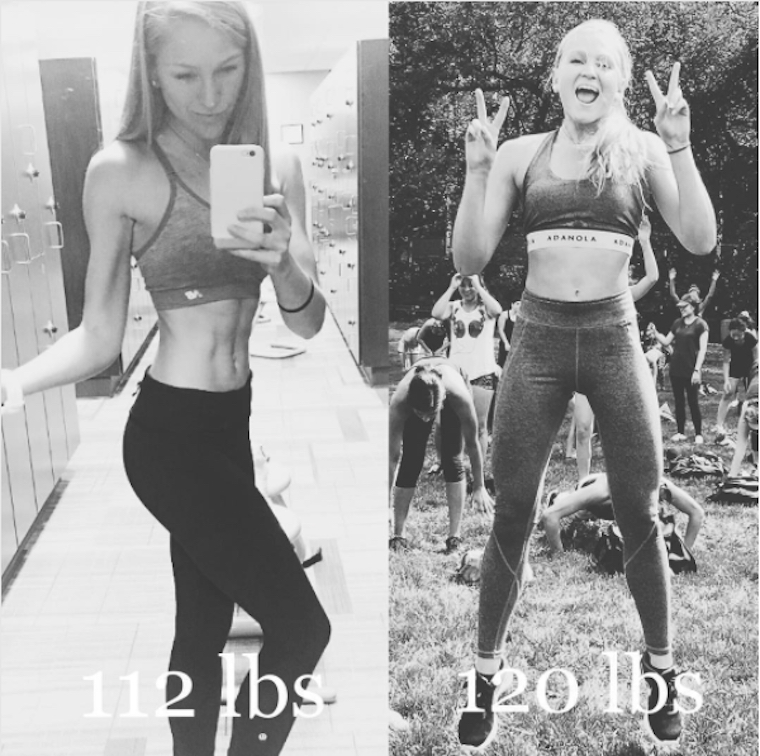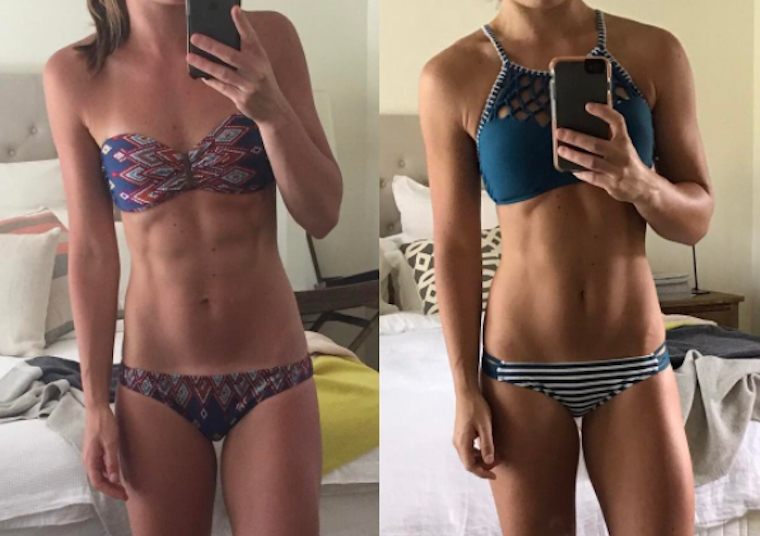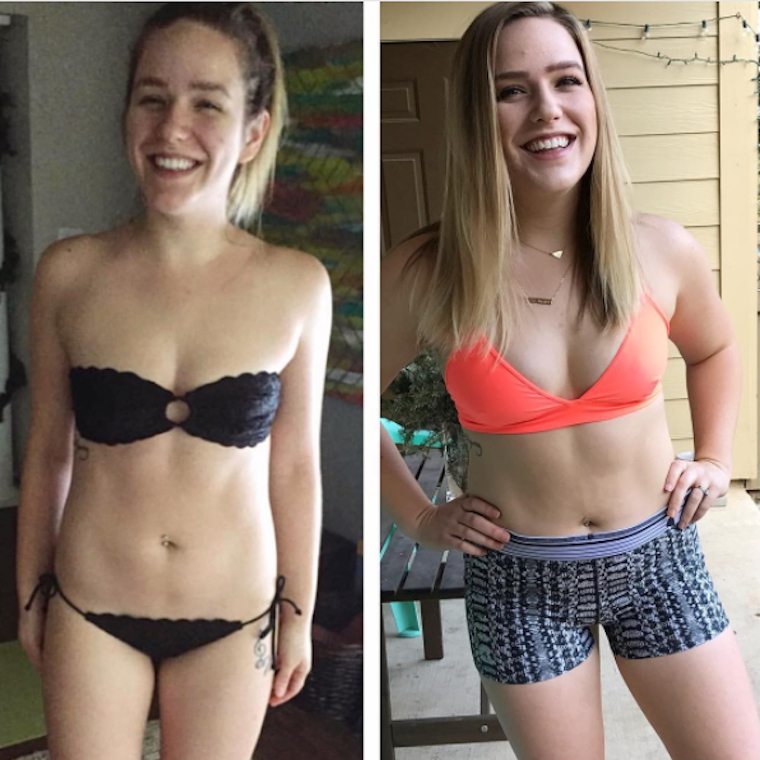Kayla Itsines’ Biggest Fans Are Breaking From the Instagram Star’s Use of Before-After Photos
The biggest fans of this particular form of fitspo are, by far, members of Kayla Itsines’ #BBG girl gang—millions of whom have posted pics of their physical evolutions online since the Australian trainer launched her super-successful "Bikini Body Guides" in 2014. Itsines herself regularly regrams before-and-after shots from her nearly eight million followers as a means of motivating the sweaty masses that subscribe to her workouts.
But some of the online community's staunchest supporters are starting to question whether these traditional, weight loss-obsessed transformation photos are actually doing women more harm than good—including their subjects themselves.
Against a backdrop of increasing Insta-trainer honesty, the reverse-transformation selfie is taking hold. And most surprising is that, while Itsines herself has yet to really weigh in on the issue (in a 2016 interview she said she regretted naming her program BBG, but has since gone on to release a cookbook utilizing the "Biking Body" phrase), her fans are rejecting ultra-skinny shots—and speaking out.

{{post.sponsorText}}
Here's what you need to know about the reverse-transformation trend—and why it's a big deal, whether or not you're a #BBG girl.

The mental toll of physical makeovers
"What transformation photos don’t show you are the thoughts that are in people’s heads and how they're feeling on the inside,” says Erin Thomas, a fitness blogger based in Washington DC, who says she became obsessed with documenting her progress through selfies on her Instagram after losing 25 pounds.
“Whenever I would post [one], I would get so many likes and comments about how great I looked," she says. "It fueled my fire. Not only was I doing BBG, but I was also running like crazy and restricting my diet. It was almost as if I was trying to work out so hard just for a transformation photo—I didn’t want to look bigger than the picture I took before.”
Thomas took extreme measures to maintain her fitspo role-model status, but she's hardly alone. New studies suggests that women who post fitspiration photos online are more prone to develop eating disorders and compulsive exercise habits. "Training too hard or restricting too many calories can [also lead to] chronic sickness or infections, stress fractures, anemia, amenorrhea, and osteoporosis," warns Jason Machowsky, RD, CSSD, RCEP, CSCS, a sports dietitian and exercise physiologist at the Hospital for Special Surgery in New York City.
For Thomas, the pressure to show progress caused her to develop a serious iron deficiency. "I ran my body into severe anemia to the point where if I kept it up, I would've needed blood transfusions," she wrote in a candid photo caption to her nearly 44K followers. "And want to know what is the saddest part? About 1,300 people liked that picture on the left....I looked like a skeleton. I remember back to that picture thinking, 'Wow I look so strong in this picture,' but in real life, I could barely peel myself out of bed every morning. Trying to sustain the body on the left is NOT possible without malnourishment. Social media has a funny way of painting what the ideal female should look like."
It's not just social media, but society in general that puts too much emphasis on weight as an indicator of overall fitness, says Machowsky. "We need to be looking at many other quantitative and qualitative factors of health such as physical capacity, strength, endurance, lab values, anthropometrics, as well as mental outlook to take a more holistic view of what it means to get healthier.”

Measuring gains instead of losses
Recently, Aussie fitspo model Cass Hines shared a photo of herself with her 72K-plus followers after gaining 18 pounds of muscle, captioning the pic: “Seeing these pics side by side, I can now honestly say that being ‘skinny’ is not what I want anymore. It blows my mind to think what I can do in terms of training and the strength I have gained vs. back then.”
Her alternative transformation selfie received more than twice as many likes as other images on her feed around the same time, and Hines says she posted the pic because she wanted to be transparent with her followers.
“When I was at my thinnest, I was consuming very few calories and fighting fatigue. It wasn’t fun or sustainable,” she tells me. “I wanted to share my shift in mentality with regards to ‘skinny’ versus ‘strong.’”
Alternative transformation shots might not be flooding social media feeds quite like their weight-loss counterparts at the moment, but these odes to self-acceptance are out there—for approximately 40K more examples, check out the hashtag #gainingweightiscool.

Progress not perfection
Another fitspo role model on board with the body-positive movement is Megan Young, who shared a reverse transformation photo with her 65K Instagram followers this past New Year’s Eve, captioning it, “This is my 1st photo of 2016 next to my last. Yes, I put on some extra weight, but in exchange, I found MYSELF!”
Young says she began 2016 at her highest-ever fitness level—having completed a half-dozen rounds of BBG. She found working out to that degree unsustainable in the long run, though, and had to scale back on her exercise regimen in order to find a better work (out)-life balance. By doing so, she says she figured out how to love herself for the first time in her adult life.
"As we get older, something changes. We begin to dislike what we see in the mirror as we become exposed to media's 'perfect' portrayal of what people/young girls should look like. We stop dreaming about ourselves and start developing anxiety that we will never be 'enough.' We stop recognizing our accomplishments and start honing in on our failures," she wrote in the caption for the above pic.
So what does she see when she looks at both images today? “When you put the two photos side by side, you'd think it was a year of failure or not as many accomplishments as the year that got me the most physically fit," she says. "But the way that I went into 2017 wasn't full of pressure and angst to get a better body. It was: ‘Your body is going to do what it's going to do while you love yourself and move it and eat right and take time to live your life.’”
I'll double tap to that.
Two more body-positive trailblazers to know: The yogi behind this viral period yoga video and Chinae Alexander—whose essay on why self-worth isn't something you can measure on a scale is a must-read.
Loading More Posts...